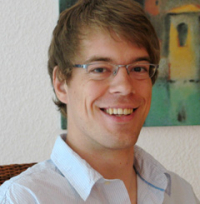Group members
| Alexander Thobe | |||||||
|
Publications(up to 2010)
-
Analyzing quantum jumps of one and two atoms strongly coupled to an optical cavity, J. Opt. Soc. Am. B 27, A152 (2010)arXivBibTeX ABSTRACT »We induce quantum jumps between the hyperfine ground states of one and two Cesium atoms, strongly coupled to the mode of a high-finesse optical resonator, and analyze the resulting random telegraph signals. We identify experimental parameters to deduce the atomic spin state nondestructively from the stream of photons transmitted through the cavity, achieving a compromise between a good signal-to-noise ratio and minimal measurement-induced perturbations. In order to extract optimum information about the spin dynamics from the photon count signal, a Bayesian update formalism is employed, which yields time-dependent probabilities for the atoms to be in either hyperfine state. We discuss the effect of super-Poissonian photon number distributions caused by atomic motion.
ABSTRACT »We induce quantum jumps between the hyperfine ground states of one and two Cesium atoms, strongly coupled to the mode of a high-finesse optical resonator, and analyze the resulting random telegraph signals. We identify experimental parameters to deduce the atomic spin state nondestructively from the stream of photons transmitted through the cavity, achieving a compromise between a good signal-to-noise ratio and minimal measurement-induced perturbations. In order to extract optimum information about the spin dynamics from the photon count signal, a Bayesian update formalism is employed, which yields time-dependent probabilities for the atoms to be in either hyperfine state. We discuss the effect of super-Poissonian photon number distributions caused by atomic motion.
-
Quantum Jumps of One and Two Atoms in a Strongly Coupled Atom-Cavity System, (2009), Diplom thesisBibTeX
-
Quantum jumps and spin dynamics of interacting atoms in a strongly coupled atom-cavity system , Phys. Rev. Lett. 103, 123006 (2009)arXivBibTeX ABSTRACT »We experimentally investigate the spin dynamics of one and two neutral atoms strongly coupled to a high finesse optical cavity. We observe quantum jumps between hyperfine ground states of a single atom. The interaction-induced normal-mode splitting of the atom-cavity system is measured via the atomic excitation. Moreover, we observe the mutual influence of two atoms simultaneously coupled to the cavity mode.
ABSTRACT »We experimentally investigate the spin dynamics of one and two neutral atoms strongly coupled to a high finesse optical cavity. We observe quantum jumps between hyperfine ground states of a single atom. The interaction-induced normal-mode splitting of the atom-cavity system is measured via the atomic excitation. Moreover, we observe the mutual influence of two atoms simultaneously coupled to the cavity mode.
Research areas
Our group
Publications
Former research topics
Teaching
Further information
Login
Colloquia
- Curtius Lectures
- 03/05/22 - 06/05/22










